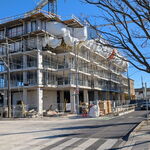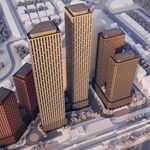1. Yonge line to Steeles (or a little further if York Region provides funding)
2. Spadina line to Steeles, period
3. Replace SRT with subway to Scarborough Centre
4. Finish Sheppard subway to Scarborough Centre
5. Eglinton Subway (how far in each direction I don't know, since I don't know the street in Toronto that well, all I can say is that subway along Eglinton in Mississauga at least would not be feasible right now, not by a long shot)
6. Downtown Relief Line (routing I'm unsure of whether Queen or another street would be better, although I'm biased toward having it go through Union
7. Expand the Bloor line further west, preferably to MCC, but at the very least Dixie/Dundas
And that's all the subway I think we'll need for a while to come
1) There is a case to go all the way to Richmond Hill Centre. Funding would not be an issue, as a combination of the investment strategy and already committed provincial funding will be enough - in my opinion anyway.
2) Spadina Line should go to VCC because it's fully funded, and turning down something that has been planned, funded and weeks away from groundbreaking is political suicide. If we ever want the people in Ottawa to take Toronto seriously, we have to play the game. Scarberiankhatru makes this argument much more eloquently.
3) The main complaints about the SRT are the capacity issues and the transfer at Kennedy. I believe that extending the SRT along Eglinton towards the west end makes use of the existing infrastructure, eliminates the transfer at Kennedy and can lead to higher capacity through upgraded signalling. I believe it can also form the basis for a network of ART lines in Scarborough to connect other destinations like STC to UTSC. As for winter operations, does anyone know how JFK's AirTrain does in the snow?
4) I'm going to wait until the RTP comes out. Forget Eglinton - this is where the real collision of ideas is going to come. By that time, the Sheppard East EA will likely be approved, and the RTP will be approved. I'm curious to see what happens.
5) In the east, this line could travel as far as West Hill, or up to UTSC. In the east, the line airport is a given, with a branch as far as Mississauga City Centre via Eglinton+Hurontario or via the Mississauga Transitway alignment.
6) I agree with you it should go through Union, but my vision of this line makes heavy use of the railway corridor.
7) I would go as far as the East Mall with a branch towards Sherway Gardens to support further high-density development occurring there. I would need to see land-use policies for Dundas before going any further because redevelopment potential is mixed. Some sites are underused, but others are successful. I still believe the best way to reach MCC is through regional rail. Passengers bound for destinations along Bloor would transfer at Kipling, while passengers heading downtown would stay onboard.




